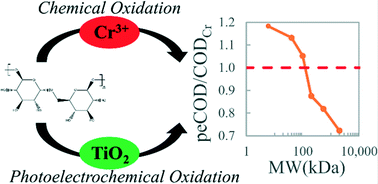Towards the real-time monitoring of industrial wastewater treatment processes via photoelectrochemical oxygen demand measurements†
Abstract
The design and operation of robust treatment processes that can handle potential process upsets require access to real-time wastewater quality data at various points in the treatment process. Organic content is an important aspect of wastewater quality, however the conventional methods of measurement (i.e. biochemical oxygen demand (BOD), dichromate chemical oxygen demand (COD), total organic carbon (TOC)) are not suitable for real-time monitoring. Photoelectrochemical oxygen demand (peCOD) is an alternative organic content parameter that can be measured in approximately 15 minutes using the high oxidizing power of UV-irradiated TiO2 nano-particles. Its application has previously only been investigated for freshwater and drinking water treatment monitoring. Herein, the accuracy of peCOD measurements for industrial wastewater samples was investigated. A set of actual industrial wastewater samples from different sources was used to compare peCOD to the conventional dichromate COD organic content parameter. Additionally, synthetic samples containing high turbidity levels and hard-to-oxidize macromolecules were analyzed. The incomplete oxidation of high molecular weight macromolecules was identified as a potential cause of lower peCOD results compared to COD results, with the molecular weight threshold for incomplete oxidation depending on the chemical structure of the macromolecule.



 Please wait while we load your content...
Please wait while we load your content...